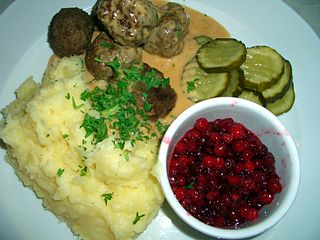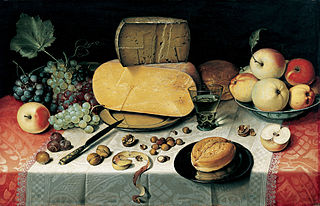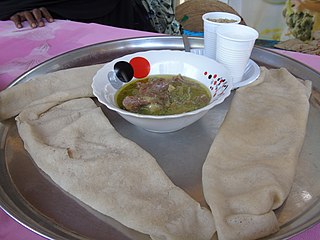
New England cuisine is an American cuisine which originated in the New England region of the United States, and traces its roots to English cuisine. It is characterized by extensive use of seafood and dairy products, resulting from its historical reliance on its seaports and fishing industry, as well as extensive dairy farming in inland regions.

Swedish cuisine is the traditional food of the Swedish. Due to Sweden's large north-to-south expanse, there are regional differences between the cuisine of North and South Sweden.

Breakfast is the first meal of the day eaten after waking from the night's sleep, usually in the morning. The word in English refers to breaking the fasting period of the previous night. There is a strong likelihood for one or more "typical", or "traditional", breakfast menus to exist in most places, but their composition varies widely from place to place, and has varied over time, so that globally a very wide range of preparations and ingredients are now associated with breakfast.

Porridge is a food commonly eaten as a breakfast cereal dish, made by boiling ground, crushed or chopped starchy plants—typically grain—in milk. It is often cooked or served with added flavourings such as sugar, honey, (dried) fruit or syrup to make a sweet cereal, or it can be mixed with spices, meat or vegetables to make a savoury dish. It is usually served hot in a bowl, depending on its consistency. Oat porridge, or oatmeal, is one of the most common types of porridge. Gruel is a thinner version of porridge.

Brazilian cuisine is the set of cooking practices and traditions of Brazil, and is characterized by, European, Amerindian, African, and most recently Asian influences. It varies greatly by region, reflecting the country's mix of native and immigrant populations, and its continental size as well. This has created a national cuisine marked by the preservation of regional differences.

A pancake is a flat cake, often thin and round, prepared from a starch-based batter that may contain eggs, milk and butter and cooked on a hot surface such as a griddle or frying pan, often frying with oil or butter. Archaeological evidence suggests that pancakes were probably the earliest and most widespread cereal food eaten in prehistoric societies.
Latvian cuisine typically consists of agricultural products, with meat featuring in most main meal dishes. Fish is commonly consumed due to Latvia's location on the eastern shore of the Baltic Sea.

Eritrean cuisine is based on Eritrea's native culinary traditions, but also arises from social interchanges with other regions. The local cuisine shares similarities with those of neighboring Ethiopia and other African countries in the region.
Serbian cuisine consists of the culinary methods and traditions of the Republic of Serbia. Its roots lie in Serbian history, including centuries of cultural contact and influence with the Byzantines, the Ottomans, the defunct state of Yugoslavia, and Serbia's Balkan neighbours. Historically, Serbian food was characterised by strong influence from Byzantine (Greek) and Mediterranean cuisines, but also by Ottoman (Turkish), and to a lesser extent Central European cuisine.

Arab cuisine is the cuisine of the Arabs, defined as the various regional cuisines spanning the Arab world, from the Maghreb to the Fertile Crescent and the Arabian Peninsula. These cuisines are centuries old and reflect the culture of trading in spices, herbs, and foods. The regions have many similarities, but also unique traditions. They have also been influenced by climate, cultivation, and mutual commerce.
Ancient Greek cuisine was characterized by its frugality for most, reflecting agricultural hardship, but a great diversity of ingredients was known, and wealthy Greeks were known to celebrate with elaborate meals and feasts.

A full breakfast is a substantial cooked breakfast meal, often served in the United Kingdom and Ireland, that typically includes bacon, sausages, eggs, black pudding, baked beans, tomatoes, mushrooms, toast, and a beverage such as coffee or tea. It appears in different regional variants and is referred to by different names depending on the area. While it is colloquially known as a "fry up" in most areas of Great Britain and Ireland, it is usually referred to as a full English breakfast in England, and as a "full Irish", "full Scottish", "full Welsh", "full Cornish", and "Ulster fry" in the Republic of Ireland, Scotland, Wales, Cornwall, and Northern Ireland, respectively.

Merienda is a light meal in southern Europe, particularly Spain, Portugal (merenda), Andorra (berenar) and Italy (merenda), as well as Hispanic America, the Philippines and Morocco and Brazil. Usually taken in the afternoon or for brunch, it fills in the meal gap between the noontime meal and the evening meal, being the equivalent of afternoon tea in the English-speaking world; or between breakfast and lunch. It is a simple meal that often consists of a piece of fruit, cookies, yogurt, and other snacks paired with juice, milk, hot chocolate, coffee, spirits, or other beverages.

Chadian cuisine is the cooking traditions, practices, foods and dishes associated with the Republic of Chad. Chadians use a medium variety of grains, vegetables, fruits and meats. Commonly consumed grains include millet, sorghum, and rice as staple foods. Commonly eaten vegetables include okra and cassava. A variety of fruits are also eaten. Meats include mutton, chicken, pork, goat, fish, lamb and beef. The day's main meal is typically consumed in the evening on a large communal plate, with men and women usually eating in separate areas. This meal is typically served on the ground upon a mat, with people sitting and eating around it.

Middle Eastern cuisine or West Asian cuisine includes Arab, Armenian, Assyrian, Azerbaijani, Cypriot, Georgian, Iranian, Palestinian, Kurdish, and Turkish cuisines. Common ingredients include olives and olive oil, pitas, honey, sesame seeds, dates, sumac, chickpeas, mint, rice and parsley, and popular dishes include kebabs, dolmas, falafel, baklava, yogurt, doner kebab, shawarma and mulukhiyah.

A meal is an eating occasion that takes place at a certain time and includes prepared food. The names used for specific meals in English vary, depending on the speaker's culture, the time of day, or the size of the meal.



















